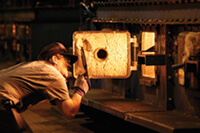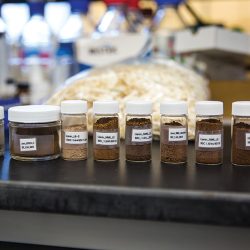Planting the Future
New Charter Street power plant will include biomass.

A worker at the Charter Street Heating Plant inspects one of the coal boilers. Replacement boilers will run on gas and biomass.
When the university’s Charter Street Heating Plant fires up its boilers in 2012, it will do so using a new fuel source: biomass.
As part of its effort to rid the south side of campus of the coal-burning, smoke-spewing eyesore, the UW will replace the plant with new equipment, including a boiler that burns plant-based matter.
The Charter Street Heating Plant has been delivering energy to campus since 1959, when the university purchased it secondhand from a defunct American Motors factory. It uses coal to fuel its boilers, and the pollution it emits violates the U.S. Clean Air Act. After the Sierra Club sued the UW, the university agreed to bring the plant into compliance by phasing in a new, cleaner, and more efficient system.
Between fall 2010 and the end of 2012, the UW will replace four of the plant’s boilers with three new ones, two of which are gas-fired and one fueled by biomass — fuel made from plants. It will also include a backup generator that runs on fuel oil.
The new Charter Street plant comes with a high price tag, however. With an estimated cost of $245 million, it would be the most expensive building project in the university’s history.
But Troy Runge of Wisconsin Biomass, who chaired the multi-agency work group that oversaw planning for the new plant, believes that including biomass will have long-range benefits to the state’s economy. He believes Wisconsin has the capacity to generate a great amount of biomass fuel, but doesn’t currently because there’s very little market for it.
Runge notes that biomass fuel can be made from what he calls “wood residuals,” or waste products of the lumber and paper industries, as well as from farm waste and crops such as prairie switchgrass, grown specifically to be turned into fuel.
“We’d like to see the Charter Street Heating Plant jump-start a biomass industry and have agriculture-based products as well as woody products,” Runge says. “Currently, there’s no biomass supply chain, but we’re hoping this will encourage the biomass economy. It could have a profound effect and create businesses that sell biomass, making it easier for development.”
By early summer, some fifty-nine companies had submitted bids to provide biomass for the university’s power plant.
Construction on the new power plant will have to wait until its design is approved for pollution control.
“The project is getting its air permits finalized,” Runge says. “That will dictate the construction timeline.”
Published in the Fall 2010 issue



Comments
No comments posted yet.